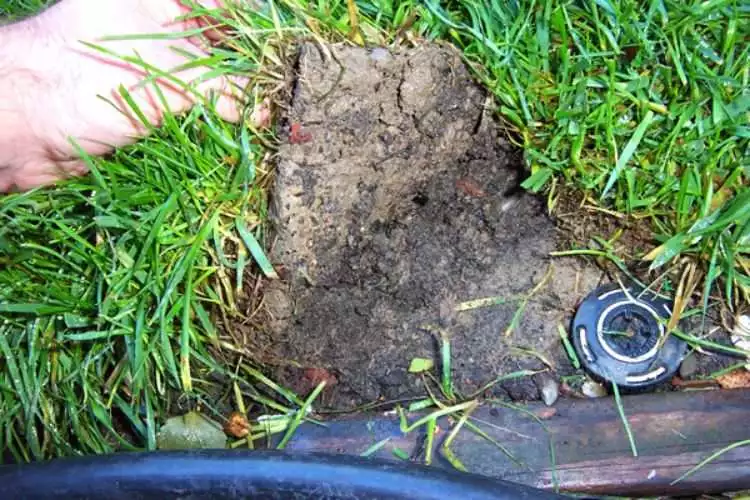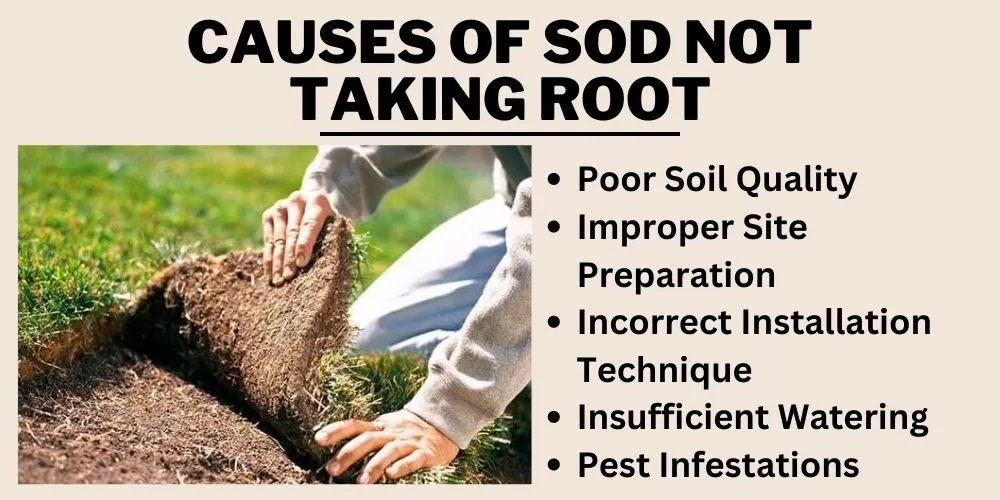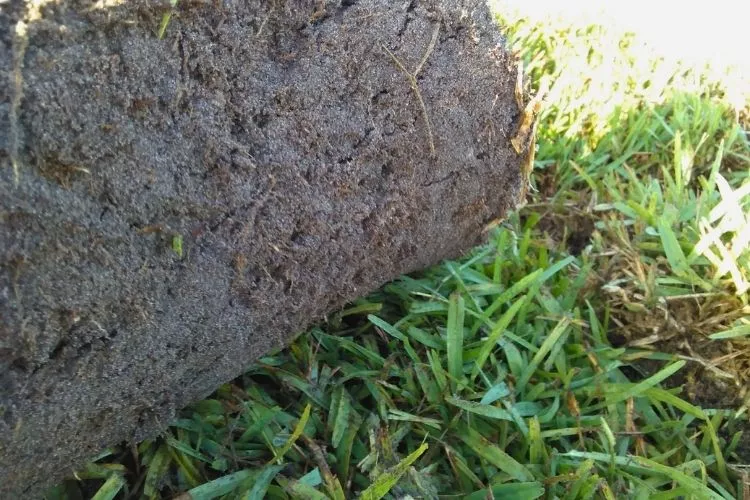After ordering the sod and laying it on your turf, you may not be happy with the growth. Upon digging, it may come to light that your sod is not taking root.
There are various reasons for sod not taking root ranging from poor soil quality to pest infection, but each has its solution. This article lists the most common reasons that stop sod from taking root and the methods you must use to address the situation.

Causes Of Sod Not Taking Root
There can be multiple reasons for your sod not taking root. From floating in the lawn to using inferior seeds at the wrong time, all these factors may contribute to your sod not turning out in the desired way.
While you may not be able to control all factors, awareness of the common ones will help address the problem better.

1. Poor Soil Quality
Healthy sod growth heavily depends on soil quality. And here is the catch: if you have to irrigate your soil daily, there is some issue with the soil quality. The layer of soil underneath the sod must be airy and not closely packed. Such compactly packed soil does not allow water to penetrate deep, requiring frequent watering.
Sod roots growing in such soil hardly get any hydration, even after frequent watering. In addition to water, such a soil structure is devoid of oxygen. Understanding the soil quality and taking appropriate steps to redress the situation is recommended.
2. Improper Site Preparation
Soil preparation to enhance the soil quality is crucial for the sod to take root. If this step has been eschewed, your sod will not take the desired shape. In an ideal case scenario, it’s essential to prep the ground extensively before sowing the sod seeds. But at times, lazy or inexperienced sod installers simply forego the soil prep process and go ahead with sowing, leading to bad outcomes. Mowing, thatching, and raking are crucial to ensure quality sod growth.
3. Incorrect Installation Technique
Suppose the proper installation steps– adequately moistened soil, laying sod against the longest edge, appropriately placing the sod seeds– and such other steps are not followed. In that case, the sod harvest will not be satisfactory. Unfortunately, people often forget to take these steps into account and end up with yellow or lumpy sod that needs to be mowed and layered again.
4. Insufficient Watering
Lack of water or insufficient supply of water causes sod to get damaged. While watering, make sure you got every spot. Sprinklers often miss spots near the edges and rim of the lawn which cause the sod growing in these spots to dry. Additionally, sod growing in areas near concrete buildings and asphalt dries out quicker due to heat. As a rule of thumb, skipping frequent watering during the early days of sowing causes your sod harvest to fail.
5. Pest Infestations
In addition to the problems listed above, pests cause havoc to sod roots. There is no telling about the varieties of lawn pests living on a property; however, grubs, chinch bugs, and armyworms cause the most damage to new sod.

While grubs attack and eat the sod root, chinch bugs drink the plant fluids rendering them dry. Armyworms, on the other hand, eat the foliage. An infestation of any of these pests can lead to yellowing, dying of sod, and patchy growth throughout the lawn.
You May Also Find Helpful: Can You Walk On New Sod?
Solutions For Sod Not Taking Root
Like the multiple reasons that stop sod from taking root, there are multiple solutions to solve the problem. Once you have determined the cause behind your poor or unsatisfactory sod growth, you must take the necessary steps to amend the situation.

1. Soil Testing And Amending
It’s mandatory to carry out extensive soil preparation before laying the sod. Many property owners advise hiring experts to conduct the process. Such professionals carry out standard soil tests to determine the kind of fertilization or other alteration the soil needs to provide a quality growth of sod. Soil tests allow the opportunity to adjust the pH level of the ground.
2. Proper Site Preparation
Skipping this step can be disastrous for your sod, preventing them from taking root. Tilling and mowing the soil is essential to aerate it. This should be followed by adding a layer of topsoil to enrich the soil with nutrients. Watering the ground is the next significant step to prepare it for sowing the sod seeds.
3. Correct Installation Technique
After following the appropriate soil preparation methods, eliminating and removing the old grass, and leveling the soil, proper methods of sod installations need to be implemented. The soil needs raking, and the sod sheets should be laid in rows on moistened turf. Each layer of the sod needs to be patted down well. Avoid standing on the freshly laid sod layers.
4. Sufficient Watering And Irrigation
Watering is crucial for new sod to develop long and deep roots, especially during the early days. It’s advisable to water the new sod as frequently as four to six times a day for 7-8 minutes during the initial days and ensure that the soil does not dry at any point. Sod has to change watering needs, and it’s crucial to follow them during the first few weeks of sowing the seed. Homeowners often resort to a watering chart to keep track of the process.
5. Pest Control Measures
Pests can be detrimental to your sod harvest. Thankfully you can keep them at bay by using fungicides and pesticides on your lawn regularly. Debris makes excellent hiding ground for pesky pests, so it’s best to eliminate any debris. You can use them in your composts at a separate location. Many people plant a few insect-repelling plants to keep pests out of their lawns.
As pests vary from region to region, it’s important to be aware of the common pests in your area to determine the best way to deal with the situation.
Frequently Asked Questions (FAQs)
How long does it take for new sod to take root?
Sod does not take over two weeks to grow a strong, long rooting system. In just one month, the grass is fully formed. This is the appropriate time to mow your new lawn for the first time after laying the sod. However, the mower should be used carefully so that it doesn’t cut close to the roots.
Does dormant sod take root?
Dormant sod does take root but not extensively. However, they start to grow during winter if they find the right conditions, like adequately watered soil. However, windy days can cause the sod to dry out on the edges and seams quickly.
How do you encourage roots to grow in sod?
Keeping your sod moist with adequate watering is the key to encouraging desired growth. Sod is delicate in the first few weeks of installation, requiring proper care. It’s best to avoid foot traffic during this time.
Conclusion:
Your sod may not be taking root for the reasons we have listed in this article, but there are ways to address the problems and remedy the situation. Keeping your
